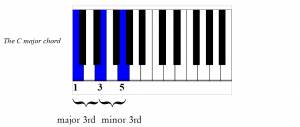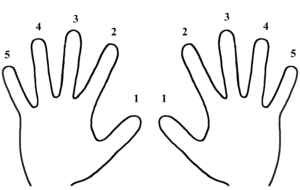Major chords consist of three notes that are stacked upon one another. The first one is the root. For the C major chord the root is C.
The next note is located at the interval of a major third above the root. For the key of C, the major third is E. The third note is the fifth. You can arrive at it by stacking a minor third upon the second note. For the key of C, the fifth is G.


A much simpler way to arrive at major chords is by counting the half steps.
The major third is 4 half steps up from the root. The fifth is another 3 half steps (or the interval of a minor third) up. So you just need to remember two numbers:
3 + 4 halfsteps
to create a major chord in any key.
If you take another starting point – say, Ab – you will arrive at the third C by counting 4 half steps up. The fifth, Eb, is another three half steps up from C.
The fingering for all major chords is
1 – 3 – 5 in the right hand, and
5 – 3 – 1 in the left hand.


